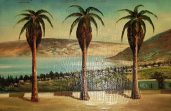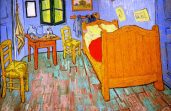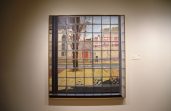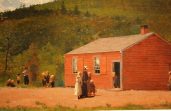The Panama Canal – Is America Still Dreaming
“The plan was wildly ambitious. But Roosevelt had backed it, and Stevens was confident it could be done. ‘There is no element of mystery involved in it,’ Stevens reported to Washington, ‘the problem is one of magnitude, not miracles.’”Recently, I watched “Panama Canal”, on The American Experience. Initially, I thought perhaps I had already seen this documentary, as I am drawn to the subject matter, having spent time in Panama, when I was eighteen years old; but a few minutes into the film, I was mesmerized and no longer cared whether or not this material was new to me.
Had I had the slightest head for numbers or simply been a man, I certainly would have become an engineer. (Yes, I am showing my age – though I feel I must add that my Aunt Helen consistently bragged about how her daughter, Linda, who is a few years older than me, was the first woman graduated from the Purdue Engineering program)
There is something rather marvelous about staring out at metal, stone, and sand that has carefully been crafted and combined to create a bridge over an otherwise impassable body of water or range of mountains, or a building which reaches up into the heaves, as if it could touch the moon and stars, or a fifty mile canal carved through the jungle of Panama, able to unite the Pacific and Atlantic Oceans!
The concept of a canal was first spoken of by the Spanish conquistadores in the sixteenth century, who hoped to shorten the path between New World gold and Old World treasuries. Francisco Lopez de Gomara, a Spanish priest had said “There are mountains, but there are also hands, and for a king of Castile, few things are impossible.” But without the aid of a steam engine, hydraulic engineering, a swinging boom, mounted on a rail road car, five million bags and barrels of concrete, which was mixed and then hoisted by crane, to be poured from the air, and the knowledge of how malaria and yellow fever were transmitted, a canal could never have been built. (p. 26-27 and film)
President Andrew Jackson had actually sent Colonel Charles Biddle to Central America, to determine whether or not a canal could be built, the Colonel was not impressed with what he saw, and thought the project impossible. (p. 31)
But suddenly, the need for a canal was once again brought to the forefront of America, when James W. Marshall at Sutter Mill’s, in Coloma California, discovered gold in January of 1848. Within a year, the race was once again on to find a simpler way to arrive in California from the east coast. In 1850 a railroad was begun, and five years and eight million dollars later, it was finished. (p. 35). Panama was a harsh mistress, and it is said that for every railroad tie between Colon and Panama City, a man lost his life, which would place the death toll at around 74,000 men, a figure impossibly high. However, it is true that so many men died, that those who were unknown, and or without family to claim them, were packed in large barrels and shipped to medical schools and hospitals around the world to serve as cadavers for medical students to study; this profitable sideline paid for a hospital at Colon, for the Panamanian Railroad Company. (p. 37)
Still the railroad was not enough; the ever shrinking world demanded a faster way for ships to sail between Europe, the Americas, and Asia. The French, led by Ferdinand de Lesseps, had already succeeded in “turning Africa into an island” by building the 105 mile Suez Canal, which brought Europe and India 5,800 miles closer. (p. 25)
Ferdinand de Lesseps had done the impossible with the help of the steam engine, a cousin empress and “What he was – what he became – was the entrepreneur extraordinaire, with all the requisite traits for the role: nerve, persistence, dynamic energy, a talent for propaganda, a capacity for deception, imagination. He was a bit of an actor and as shrewd and silky as diplomat as anyone of his time.” (p. 53)
In 1880, having gained fame, honor, and financial success, de Lesseps set his sights on a new endeavor; he began efforts to build a canal in Panama. He envisioned a canal at sea level, without tunnels or locks, along the path of the railroad. During the next eight years, over twenty one thousand men lost their lives in what would become a catastrophic failure which cost 1,435,000,000 francs, about 1,000,000,000 more than the Suez Canal, and the reputation of a man who had conquered so much only to lose it all. (p. 235)
The death toll would mount, by 5,600, and another three hundred and fifty million dollars would be spent, when the United States decided that they would master the jungle, and connect the world. It is an amazing story of triumph and sacrifice and will, which began in 1904, at the dawn of what would become the American Century.
As I watched the film, which focused on the American construction, there were several things which struck me. First, the role of immigrants in our American story, which the film captured in Jan and Rose van Hardeveld’s life, secondly, the power of innovation, which is so beautifully dramatized of course by extraordinary engineering feats, but also by Dr. Colonel William Gorgas, and thirdly our notion of manifest destiny, in the broadest of senses.
Jan van Hardeveld, a 30-year-old engineer from Wyoming, who had come to Panama to work, was born in the Netherlands, said: “In America, anything is possible.” He wrote to his wife, Rose: “the food is awful, and cooked in such a way that no civilized white man can stand it for more than a week or two . . . I grew careless last week and before I realized it, I was one sick hombre — stomach out of order, and my blood full of malaria bugs… I’m taking no more chances than I can help of being sent home wrapped in a wooden overcoat.” Nevertheless, he later told her: “the slowness of work would be discouraging, if I were not certain that our Government can and will accomplish whatever it sets out to do. That is why, since you have made no objection, I have made my decision to stay, and I am happy to be able to tell you that the quartermaster has at last assigned me to married quarters. The house is an old one at Las Cascadas, the village where I am now working. It was the first house built here by the French, and is marked ‘House Number One.’”
In the winter of 1906, Rose, a housewife, living in Wyoming, began her journey to Panama. She gathered her children, and told them: “This will be our chance to be among those who make history! Your Papa is helping to build the big canal, the waterway that has been in the minds of men for centuries. It will unite the two oceans, the Atlantic and the Pacific, and alter the course of the ships that sail upon them. This canal, when it is finished, will change the face of the earth.” How in the world did this woman manage such insight and faith?
Her life in Panama was hard and still lonely, as her husband worked impossible hours and she was left to deal with the daily chores of feeding and tending to her children, yet she never lost hope in the vision she shared with her husband. She took her children to see President Roosevelt, who for so many was the chief architect of this endeavor, saying: “We saw him once, on the end of a train. Jan got small flags for the children, and told us about when the train would pass, so we were standing on the [front] steps. Mr. Roosevelt flashed us one of his well-known toothy smiles and waved his hat at the children as though he wanted to come up the hill and say ‘Hello!’ I caught some of Jan’s confidence in the man. Maybe this ditch will get dug after all, I thought.”
Her husband, Jan van Hardeveld, said years later: “I couldn’t help thinking of those who worked beside me who lost their lives. I thought of the many times when I nearly gave in to doubts that the Canal could ever be completed, that it was ever meant to be. But most of all, I was remembering how my answer to my own doubts, every time, was my faith in my country. I have always believed America could accomplish anything she set out to do.”
Do we still hold that belief? Do we in this age of cynicism still believe that America can do anything she puts her mind to? Are we still the land of opportunity? Is America still home to innovation? Are we still a confidant people, willing to risk everything on what we believe?
~
Colonel William Gorgas, who was sent to Panama, as a doctor, was considered a leading specialist in yellow fever, which he had been stricken with, and recovered from, thus becoming immune. He firmly believed that he knew how to eradicate yellow fever which had ravaged Panama and decimated so much of the canal work force. The virus, which is transmitted by female mosquitos, most likely originated in Africa, and was brought to the New World after 1492, and for the majority of its victims meant a painful death.
In 1881, Cuban physician and scientist, Carlos Finlay (Juan Carlos Finlay y Barres), first put forth the notion that yellow fever might be transmitted by mosquitoes. Though not mentioned in this film, the Panama Canal would not have been completed without Finlay’s work, for which he was nominated seven times for the Nobel Prize. With the United States having lost more men to yellow fever than on the battlefields, in the war of 1898, in Cuba, it was decided to test Finlay theories. In 1900, Walter Reed with Carlos Finlay’s help, proved the theory correct. General Leonard Wood, a physician and U.S. military governor of Cuba in 1900, commented: “The confirmation of Dr. Finlay’s doctrine is the greatest step forward made in medical science since Jenner’s discovery of the vaccination (of smallpox).” William Crawford Gorgas wanted to apply what had been learned in Cuba, where yellow fever deaths had fallen by 95 percent, by simply killing the mosquitos, to Panama, in order to stop the yellow fever death toll.
http://yellowfever.lib.virginia.edu/reed/finlay.html
Gorgas’ efforts were not well received, primarily due to the cost involved and a lack of belief in the theory of a mosquito born virus. It was President Roosevelt who had to intervene, in order to allow Gorgas to carry out his plans. Roosevelt finally proclaims: “Get behind Gorgas and give him the authority and the resources he needs,” thus launching what will become “the most expensive public health campaign in history;” and the difference between failure and success. (film)
On November 11, 1906, “Gorgas called his staff into an autopsy room and told them to take a good look at the corpse on the table. It was, he rightly predicted, the last yellow fever victim they would ever see.” (ibid.) He had been right in his insistence that eradicating the mosquito would eradicate yellow fever.
~
The film ended with the following words by Matthew Parker: “It all occurred at such a pivotal moment in our history. The failure of the French effort was very much the sort of the dying gasp of the Victorian age that had been dominated by Europe. With the opening of the American canal, the power in the world had shifted irrevocably and the American century effectively could begin.”
The “successful completion of the Panama Canal had defined the United States to the world, and announced the arrival of a new power for the new century.” Jackson Lears added: “It was a symbol to Americans. This is what American power, technological know-how, determination, managerial organization, all of those things that Americans prided themselves on and still do to a certain extent, this is what it can do for the whole world.” And Ovidio Diaz Espino commented: “After 500 years of people dreaming, now it was done. The Atlantic and Pacific oceans were forever united. The United States was now firmly established as the most powerful nation on Earth.”
I was left wondering if that were true, did the canal really signal the shift in power, and did we, the United States, a century later, still have the will to make the impossible happen? The Canal had been proof of American leadership and tenacity, and it had launched us a global leader; but what of today? Did we lose our way, with the loss of the canal?
I well remember Carter signing the treaty’s which gave Panama control of the Canal, and ended the Canal Zone. It very much felt like America had lost a piece of her identity, of what made her America.
If the 20th century had been defined by America, what of the 21st? Where are we today? Where is the American dream of home ownership, employment, education, and of a brighter future? Are we out of dreams?
The shuttle missions are ending, and America will now be forced to hitch a ride with Russia to supply our space station. How did that happen? How has this happened, are our days in the sun over? To whom does this century belong? Are we only permitted to shine in one century, or can we have an impact on another?
I suppose I might argue that we made a pretty big impact on the 18th century as well, after all our revolution stirred the world; and while the 19th century saw us as a house divided, we did survive our Civil War, resolved what our founding fathers had been unable to, claimed our manifest destiny, and mastered the Industrial Revolution.
America is a young country, and some have claimed that we already burned our brightest, and that the 21st century belongs to others – I respectfully disagree. The Panama Canal was a dream for many nations over many centuries; but only America was able to make that dream a reality, and to share it with the world. What shall we dream of next? That is all for now.
(Unless otherwise noted, all quotes are from “Panama Canal”, on The American Experience)
http://www.pbs.org/wgbh/americanexperience/features/transcript/panama/
(All notes referenced by page numbers are from The Path Between the Seas: The Creation of the Panama Canal, 1870 – 1914 by David McCullough, Simon and Schuster, New York, 1977.)











